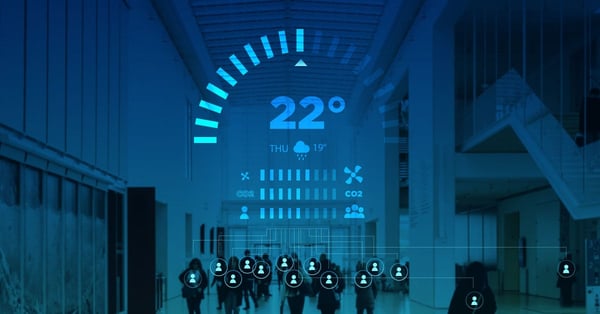What is a smart building and which trends should you know of?
The term Smart Building has been well used the last couple of years, and pushed by Covid-19 the spring 2021, as many of us was forced to change working space to home office. The pandemic also made new groups jump into the world of digitalization. From one day to another, at work become a less descibing term. Home office or at the office, and many left this period sticking to a hybrid office solution. A high variety of how many are physically at work, followed by environmental focus and the energy crisis in 2022, has increased the benefits of measuring and adjust to the needs of the tenants by days and even hours.
Let’s look at new developments and trends:
1. Real-time Energy Monitoring and Forecasting:
High prices on energy makes us eger to monitor how much energy that is consumed. Today modern building management software (BMS) provides energy usage statistics in real-time.
In addition to energy usage, ClevAir Dashboard gives you insight of:
– saved energy
– CO2 emission related to the building
– comparison of performance of buildings in your portfolio (letting you know where to take action)
2. Occupancy based HVAC Control in a Smart Building
One of the primary reasons for buildings overconsuming energy is manual HVAC systems. If HVAC systems have no dynamic settings based on the building occupancy, they are simply controlled by fixed time schedules (perhaps all year around).
Smart buildings can offer occupancy based HVAC control. The ClevAir-solution uses sensors that send measurements of temperature and the level of CO2, and algorithms optimize the ventilation in real-time. Let us explain; a lot of people means a high level of CO2 causing ClevAir to increase the amount of air that is pumped into the building, or the opposite at low occupancy. This results in savings. An example, a tenant has a salesforce that is out visiting customers most of the time and meaning they can save cost. But the solution will also increase the comfort for the finance department when they work long hours at the end of every month.
Learn more about building automation in our guide
3. Energy Efficiency by Weather Forecasts
As a Nordic company, we are used to quick changes in the outside temperature. At summer time we experience sunny warm days with sudden rain showers that lowers the temperature by 5-10 degrees C. During winter one week can differ from minus 5 to minus 16 C. Changes like this can be used for energy efficiency, ClevAir use weather information to save energy. A weather forecast for summer rain showers means no need to cool down the building in the morning like it had to the previous day with a forecast of 25 C.
4. Control and Reduction of Waste
A sustainable building has solutions for its waste. Remember, that waste is not only rubbish, it might be of value as well! An example is the Norwegian PropTech company Carrot. Their software solution gives insight and motivates towards a sustainable behavior and circular economy.
Other solutions help the cafeteria to avoid waste of food.
5. Remote Management of a Smart Building
Another excellent smart building characteristic is remote management. The ability to control the lighting, ventilation, security of your building remotely is a very convenient and desirable feature of smart buildings. By the knowledge of the email address of tenants a lot of administration can be done by the user him/her self. Downloading an app is all that is needed in order to get access to the building, cabinets, paying for your lunch etc.
6. Optimization of M2
Using hybrid office (office and home office) results in a lot of empty desks and m2. With technology measuring occupancy leads companies to be able to rent out space they don’t use anymore. Sharing resources is both sustainable and economic.
For other tenants renting out is not possible. But in a smart building one can optimize services, like cleaning to only clean spaces that have been used or only turn on light, heating and ventilation when used.
Final Word:
The rising prevalence of smart buildings is great for both people and the environment. A healthy, regulated indoor climate makes for a convenient user experience; whereas a decreased utilization of energy ensures reduced carbon emissions. The process of retrofitting old buildings into smart ones has also been simplified by the implementation of the aforementioned trends in modern BMS solutions like ClevAir.





Comments
Add Comment